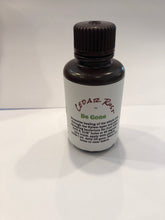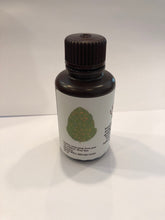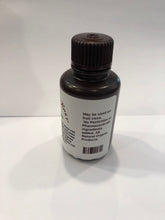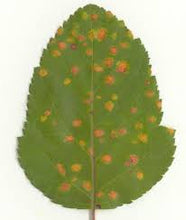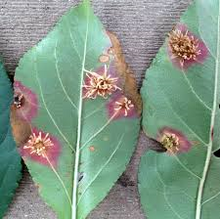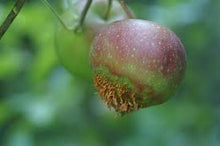
Cedar Rust Be Gone ™.Safely promotes healing of the whole tree for Cedar Rust disease. All organic plant ingredients. Drill 8 holes at 45 degree angle about .125" to .625" ( 5/8") deep. Apply about 1 ml per hole ( one pipette full), do not overflow hole. The drill bit size is best at 3/16" in diameter. Repeat this 4 different days until all 60 ml is gone. Shake well before using. Keep away from pets and children. Wear eye protection, DO NOT SPRAY. Visit web site https://blackknotbegone.com for more information.
If the tree is over 4 inches in diameter drill 8 holes if the tree is less than 4 inches in diameter only drill 4 holes
Pipette size - will hold 1.2 ml
When drilling the 8 holes, please make sure to ream them out to clean out all debris. This will allow the black knot to be gone to fill the cavity and absorb through the vascular system. The older the tree the deeper you will need to drill it is ok to drill deeper to ensure you drill into the xylem layers vascular system.
Shake the Cedar Rust Be Gone Very Well before Applying.
OK to use a 3/16" drill bit to drill 45-degree angles up to 5/8" deep into the trunk of the tree.
Make sure you clean out each hole by running the drill and pushing and pulling out the drill bit to clean out the debris.
Drill 8 holes around the trunk of the tree about 6-12" from the ground if the tree is 4 inches or larger.
The 45 degree angle is to utilize the capillary action in the tree to feed the whole tree. If the tree is less than 4" in diameter only drill 4 holes into the trunk of the tree.
Use the pipette that shipped with the product and apply about 1 ml per hole per day to each hole. Apply so the product does not overfill hole and run down the tree.
You can seal up the holes with only a natural product, do not use paint or petroleum-based sealant. Some people have had good luck with beeswax.
You can apply black knot be gone any time the tree is absorbing nutrients up through the root system, early spring to late fall. The best time is any time you see the black knot disease on the tree and then again in early spring for preventative protection. The tree is the most susceptible as the fungus spores are airborne in the early spring.
Cedar Rust from Juniper trees (Cedar) to Fruit trees
Spring 2020
This application has a yellow apple tree that is in CT. with a cedar tree infected with Cedar Rust. The Cedar trees (Juniper) will infect apple and other fruit trees by airborne method. You can see from this image of the apple tree in foreground and the cedar trees infected in the background below.


The close-up image of the cedar rust fungus is the cause of the infection of the apple tree.
Cedar apple rust (Gymnosporangium juniperi-virginianae) is a fungal disease that from (cedar) juniper plants. Spores overwinter as a brown gall on twigs of many juniper species. In early spring, during wet weather, these galls swell and bright orange masses of spores are blown by the wind where they infect susceptible apple trees. The spores that develop on these trees will only infect junipers the following year. From year to year, the disease must pass from junipers to apples to junipers again; it does not spread between apple trees.
Apple trees may show pale yellow tiny sized spots on the upper surface of the leaves just after bloom. These gradually grow to bright orange-yellow spots which make the disease easy to spot. Orange spots may develop on the fruit as well. Heavily infected leaves may drop prematurely.
Application of Cedar Rust Be Gone ™
The yellow apple tree had an application of the Cedar Rust Be Gone™ by drilling 45-degree angle holes around the tree and applied by pipette. This application was applied on 4-27-2020. The yellow apple tree has been infected before the application on 4-27-2020. This condition has been a lengthy yearly battle with many traditional products that have not been effective in eliminating the cedar rust from the yellow apple tree. The early arrival of the cedar rust above on the juniper tree usually will infect the apple tree enough to curl up the leaves and drop just as they appear in the spring.

Picture taken 5-10, thirteen days after the first application of Cedar Rust Be Gone. The yellow apple tree has been infected yearly from a Neighbors juniper tree and has been treated yearly with bonide product. The cedar rust killed two of the three trees three years ago. The Bonide , Multipurpose Fungicide product did not protect the leaves or the fruit from the cedar rust infection. The treatments were placed each year multiple times
for over 5 years. This year the bonide product will not be used to verify the effectiveness of the Cedar Rust Be Gone.
The juniper tree (cedar) developed many new flowers on 5-16 and exposed the yellow apple with the cedar rust disease again.
The application was a little late as the Cedar rust on the juniper tree blossomed and released the fungus airborne to the yellow apple tree located close by.
The picture here indicates the newly blossomed leaves are not infected with the cedar rust. The healthy leaves are a good sign that the Cedar rust be gone provided some protection to the yellow apple tree from the airborne cedar rust.

Here is a picture of the apple tree on 6-1-2020. The application of the cedar rust be gone missed some days and ended the application on 5-20-2020.
The overall tree has some cedar rust located on “isolated random leaves around the tree, normally the whole tree would be infected”. The evidence indicates the cedar rust be gone has had a new and different solution to this state of the disease based on previous years of tree loss to this disease.
Updates will be added for the fruit pictures and all the leaves ability to heal from the cedar rust.






